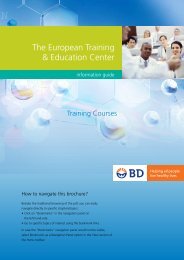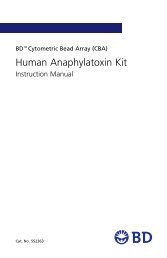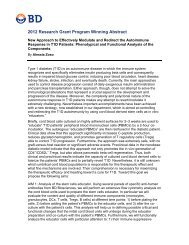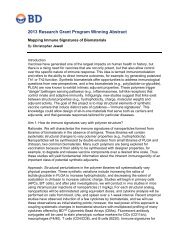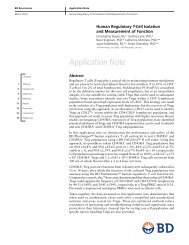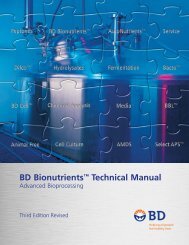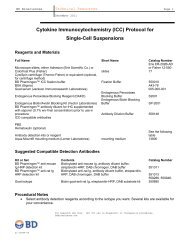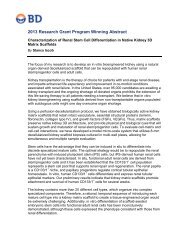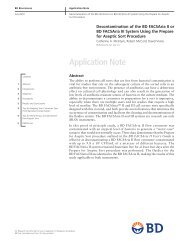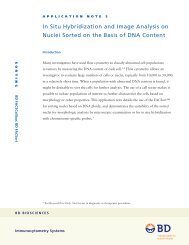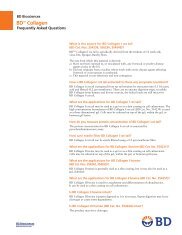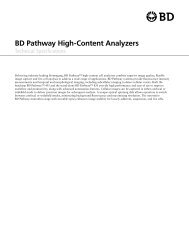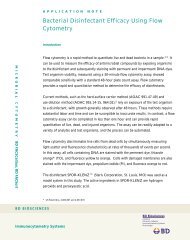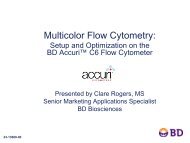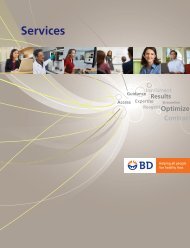BD Cytometric Bead Array (CBA) Human Th1/Th2 ... - BD Biosciences
BD Cytometric Bead Array (CBA) Human Th1/Th2 ... - BD Biosciences
BD Cytometric Bead Array (CBA) Human Th1/Th2 ... - BD Biosciences
You also want an ePaper? Increase the reach of your titles
YUMPU automatically turns print PDFs into web optimized ePapers that Google loves.
<strong>BD</strong> <strong>Cytometric</strong> <strong>Bead</strong> <strong>Array</strong><br />
(<strong>CBA</strong>) <strong>Human</strong> <strong>Th1</strong>/<strong>Th2</strong>/<strong>Th1</strong>7<br />
Cytokine Kit<br />
Instruction Manual<br />
Catalog No. 560484
ii<br />
<strong>BD</strong> <strong>CBA</strong> <strong>Human</strong> <strong>Th1</strong>/<strong>Th2</strong>/<strong>Th1</strong>7 Cytokine Kit<br />
Copyrights<br />
© 2010, Becton, Dickinson and Company. All rights reserved. No part of this publication may<br />
be reproduced, transmitted, transcribed, stored in retrieval systems, or translated into any<br />
language or computer language, in any form or by any means: electronic, mechanical,<br />
magnetic, optical, chemical, manual, or otherwise, without prior written permission from<br />
<strong>BD</strong> <strong>Biosciences</strong>.<br />
The information in this guide is subject to change without notice. <strong>BD</strong> <strong>Biosciences</strong> reserves the<br />
right to change its products and services at any time to incorporate the latest technological<br />
developments. Although this guide has been prepared with every precaution to ensure<br />
accuracy, <strong>BD</strong> <strong>Biosciences</strong> assumes no liability for any errors or omissions, nor for any damages<br />
resulting from the application or use of this information. <strong>BD</strong> <strong>Biosciences</strong> welcomes customer<br />
input on corrections and suggestions for improvement.<br />
Trademarks<br />
FCAP <strong>Array</strong> is a registered trademark of Softflow, Inc.<br />
Macintosh and Mac are trademarks of Apple Computer, Inc., registered in the US and other<br />
countries.<br />
<strong>BD</strong>, <strong>BD</strong> Logo and all other trademarks are the property of Becton, Dickinson and Company.<br />
© 2010 <strong>BD</strong><br />
Regulatory information<br />
<strong>BD</strong> flow cytometers are class I (1) laser products.<br />
For Research Use Only. Not for use in diagnostic or therapeutic procedures.<br />
History<br />
Revision Date Change made<br />
647210 2/09 Initial document<br />
23-12381-00 Rev. 01 10/2010 Setup and acquisition instructions removed
Contents<br />
Chapter 1: About this kit . . . . . . . . . . . . . . . . . . . . . . . . . . . . . . . . . . . . 5<br />
Purpose of the kit . . . . . . . . . . . . . . . . . . . . . . . . . . . . . . . . . . . . . . . 6<br />
Limitations . . . . . . . . . . . . . . . . . . . . . . . . . . . . . . . . . . . . . . . . . . . . 8<br />
Kit contents . . . . . . . . . . . . . . . . . . . . . . . . . . . . . . . . . . . . . . . . . . . . 9<br />
Storage and handling . . . . . . . . . . . . . . . . . . . . . . . . . . . . . . . . . . . . 11<br />
Chapter 2: Before you begin . . . . . . . . . . . . . . . . . . . . . . . . . . . . . . . . 13<br />
Workflow overview . . . . . . . . . . . . . . . . . . . . . . . . . . . . . . . . . . . . . 14<br />
Required materials . . . . . . . . . . . . . . . . . . . . . . . . . . . . . . . . . . . . . . 15<br />
Chapter 3: Assay preparation . . . . . . . . . . . . . . . . . . . . . . . . . . . . . . . 17<br />
Preparing <strong>Human</strong> <strong>Th1</strong>/<strong>Th2</strong>/<strong>Th1</strong>7 Cytokine Standards . . . . . . . . . . . 18<br />
Mixing <strong>Human</strong> <strong>Th1</strong>/<strong>Th2</strong>/<strong>Th1</strong>7 Cytokine Capture <strong>Bead</strong>s . . . . . . . . . 20<br />
Diluting samples . . . . . . . . . . . . . . . . . . . . . . . . . . . . . . . . . . . . . . . 21<br />
Chapter 4: Assay procedure . . . . . . . . . . . . . . . . . . . . . . . . . . . . . . . . 23<br />
Performing the <strong>Human</strong> <strong>Th1</strong>/<strong>Th2</strong>/<strong>Th1</strong>7 Cytokine Assay . . . . . . . . . . 24<br />
Data Analysis . . . . . . . . . . . . . . . . . . . . . . . . . . . . . . . . . . . . . . . . . 27<br />
Chapter 5: Performance . . . . . . . . . . . . . . . . . . . . . . . . . . . . . . . . . . . . 31<br />
Theoretical limit of detection . . . . . . . . . . . . . . . . . . . . . . . . . . . . . . 32<br />
Recovery . . . . . . . . . . . . . . . . . . . . . . . . . . . . . . . . . . . . . . . . . . . . . 33<br />
Linearity . . . . . . . . . . . . . . . . . . . . . . . . . . . . . . . . . . . . . . . . . . . . . 35<br />
Specificity . . . . . . . . . . . . . . . . . . . . . . . . . . . . . . . . . . . . . . . . . . . . 37<br />
Precision . . . . . . . . . . . . . . . . . . . . . . . . . . . . . . . . . . . . . . . . . . . . . 39<br />
Chapter 6: Reference . . . . . . . . . . . . . . . . . . . . . . . . . . . . . . . . . . . . . . 41<br />
Troubleshooting . . . . . . . . . . . . . . . . . . . . . . . . . . . . . . . . . . . . . . . 42<br />
References . . . . . . . . . . . . . . . . . . . . . . . . . . . . . . . . . . . . . . . . . . . . 43<br />
For Research Use Only. Not for use in diagnostic or therapeutic procedures.
This section covers the following topics:<br />
� Purpose of the kit (page 6)<br />
� Limitations (page 8)<br />
� Kit contents (page 9)<br />
� Storage and handling (page 11)<br />
For Research Use Only. Not for use in diagnostic or therapeutic procedures.<br />
1<br />
About this kit
6<br />
<strong>BD</strong> <strong>CBA</strong> <strong>Human</strong> <strong>Th1</strong>/<strong>Th2</strong>/<strong>Th1</strong>7 Cytokine Kit<br />
Purpose of the kit<br />
Use of the kit The <strong>BD</strong> <strong>CBA</strong> <strong>BD</strong> <strong>CBA</strong> <strong>Human</strong> <strong>Th1</strong>/<strong>Th2</strong>/<strong>Th1</strong>7<br />
Cytokine Kit can be used to measure Interleukin-2 (IL-<br />
2), Interleukin-4 (IL-4), Interleukin-6 (IL-6), Interleukin-<br />
10 (IL-10), Tumor Necrosis Factor (TNF), Interferon-γ<br />
(IFN-γ), and Interleukin-17A (IL-17A) protein levels in a<br />
single sample. The kit performance has been optimized<br />
for analysis of physiologically relevant concentrations<br />
(pg/mL levels) of specific cytokine proteins in tissue<br />
culture supernatants, EDTA plasma, and serum samples.<br />
The kit provides sufficient reagents for 80 tests.<br />
Principle of <strong>CBA</strong><br />
assays<br />
<strong>BD</strong> <strong>CBA</strong> assays provide a method of capturing a soluble<br />
analyte or set of analytes with beads of known size and<br />
fluorescence, making it possible to detect analytes using<br />
flow cytometry.<br />
Each capture bead in a <strong>BD</strong> <strong>CBA</strong> kit has been conjugated<br />
with a specific antibody. The detection reagent provided<br />
in the kit is a mixture of phycoerythrin (PE)–conjugated<br />
antibodies, which provides a fluorescent signal in<br />
proportion to the amount of bound analyte.<br />
When the capture beads and detector reagent are<br />
incubated with an unknown sample containing<br />
recognized analytes, sandwich complexes (capture bead<br />
+ analyte + detection reagent) are formed. These<br />
complexes can be measured using flow cytometry to<br />
identify particles with fluorescence characteristics of<br />
both the bead and the detector.<br />
For Research Use Only. Not for use in diagnostic or therapeutic procedures.
Principle of this<br />
assay<br />
Chapter 1: About this kit<br />
The <strong>BD</strong> <strong>CBA</strong> <strong>BD</strong> <strong>CBA</strong> <strong>Human</strong> <strong>Th1</strong>/<strong>Th2</strong>/<strong>Th1</strong>7 Cytokine<br />
Kit uses bead array technology to simultaneously detect<br />
multiple cytokine proteins in research samples. Seven<br />
bead populations with distinct fluorescence intensities<br />
have been coated with capture antibodies specific for IL-<br />
2, IL-4, IL-6, IL-10, TNF, IFN-γ, and IL-17A proteins.<br />
The seven bead populations are mixed together to form<br />
the bead array, which is resolved in a red channel (ie,<br />
FL3 or FL4) of a flow cytometer.<br />
Figure 1<br />
During the assay procedure, you will mix the cytokine<br />
capture beads with the recombinant standards or<br />
unknown samples and incubate them with the PEconjugated<br />
detection antibodies to form sandwich<br />
complexes. The intensity of PE fluorescence of each<br />
sandwich complex reveals the concentration of that<br />
cytokine. After acquiring samples on a flow cytometer,<br />
use FCAP <strong>Array</strong> software to generate results in<br />
graphical and tabular format.<br />
For Research Use Only. Not for use in diagnostic or therapeutic procedures.<br />
7
8<br />
<strong>BD</strong> <strong>CBA</strong> <strong>Human</strong> <strong>Th1</strong>/<strong>Th2</strong>/<strong>Th1</strong>7 Cytokine Kit<br />
Advantages over<br />
ELISA<br />
Limitations<br />
The broad dynamic range of fluorescent detection via<br />
flow cytometry and the efficient capturing of analytes via<br />
suspended particles enable the <strong>BD</strong> <strong>CBA</strong> assay to measure<br />
the concentration of an unknown in substantially less<br />
time and using fewer sample dilutions compared to<br />
conventional ELISA methodology.<br />
� The required sample volume is approximately oneseventh<br />
the quantity necessary for conventional<br />
ELISA assays due to the detection of seven analytes<br />
in a single sample.<br />
� A single set of diluted standards is used to generate a<br />
standard curve for each analyte.<br />
� A <strong>BD</strong> <strong>CBA</strong> experiment takes less time than a single<br />
ELISA and provides results that would normally<br />
require seven conventional ELISAs.<br />
Assay limitations The theoretical limit of detection of the <strong>BD</strong> <strong>CBA</strong> <strong>BD</strong><br />
<strong>CBA</strong> <strong>Human</strong> <strong>Th1</strong>/<strong>Th2</strong>/<strong>Th1</strong>7 Cytokine Kit is comparable<br />
to conventional ELISA, but due to the complexity and<br />
kinetics of this multi-analyte assay, the actual limit of<br />
detection on a given experiment may vary. See<br />
Theoretical limit of detection (page 32) and Precision<br />
(page 39).<br />
The <strong>BD</strong> <strong>CBA</strong> Kit is not recommended for use on streamin-air<br />
instruments for which signal intensities may be<br />
reduced, adversely affecting assay sensitivity. Stream-inair<br />
instruments include the <strong>BD</strong> FACStar Plus,<br />
<strong>BD</strong> FACSVantage, and <strong>BD</strong> Influx flow cytometers<br />
(<strong>BD</strong> <strong>Biosciences</strong>).<br />
For Research Use Only. Not for use in diagnostic or therapeutic procedures.
Kit contents<br />
Chapter 1: About this kit<br />
Quantitative results or protein levels for the same sample<br />
or recombinant protein run in ELISA and <strong>BD</strong> <strong>CBA</strong><br />
assays may differ. A spike recovery assay can be<br />
performed using an ELISA standard followed by <strong>BD</strong><br />
<strong>CBA</strong> analysis to assess possible differences in<br />
quantitation.<br />
This kit is designed to be used as an integral unit. Do not<br />
mix components from different batches or kits.<br />
Contents The <strong>BD</strong> <strong>CBA</strong> <strong>Human</strong> <strong>Th1</strong>/<strong>Th2</strong>/<strong>Th1</strong>7 Cytokine Kit<br />
contains the following components sufficient for 80<br />
tests.<br />
Vial<br />
label Reagent Quantity<br />
A1 <strong>Human</strong> IL-2 Capture <strong>Bead</strong>s 1 vial, 0.8 mL<br />
A2 <strong>Human</strong> IL-4 Capture <strong>Bead</strong>s 1 vial, 0.8 mL<br />
A3 <strong>Human</strong> IL-6 Capture <strong>Bead</strong>s 1 vial, 0.8 mL<br />
A4 <strong>Human</strong> IL-10 Capture <strong>Bead</strong>s 1 vial, 0.8 mL<br />
A5 <strong>Human</strong> TNF Capture <strong>Bead</strong>s 1 vial, 0.8 mL<br />
A6 <strong>Human</strong> IFN-γ Capture <strong>Bead</strong>s 1 vial, 0.8 mL<br />
A7 <strong>Human</strong> IL-17A Capture <strong>Bead</strong>s 1 vial, 0.8 mL<br />
B <strong>Human</strong> <strong>Th1</strong>/<strong>Th2</strong>/<strong>Th1</strong>7 PE<br />
Detection Reagent<br />
1 vial, 4 mL<br />
C <strong>Human</strong> <strong>Th1</strong>/<strong>Th2</strong>/<strong>Th1</strong>7<br />
Cytokine Standards<br />
2 vials, 0.2 mL<br />
lyophilized<br />
D Cytometer Setup <strong>Bead</strong>s 1 vial, 1.5 mL<br />
E1 PE Positive Control Detector 1 vial, 0.5 mL<br />
E2 FITC Positive Control Detector 1 vial, 0.5 mL<br />
For Research Use Only. Not for use in diagnostic or therapeutic procedures.<br />
9
10<br />
<strong>BD</strong> <strong>CBA</strong> <strong>Human</strong> <strong>Th1</strong>/<strong>Th2</strong>/<strong>Th1</strong>7 Cytokine Kit<br />
<strong>Bead</strong> reagents <strong>Human</strong> Cytokine Capture <strong>Bead</strong>s (A1–A7): An 80-test<br />
vial of each specific capture bead (A1–A7). The specific<br />
capture beads, having discrete fluorescence intensity<br />
characteristics, are distributed from brightest (A1) to<br />
dimmest (A7).<br />
Antibody and<br />
standard<br />
reagents<br />
Vial<br />
label Reagent Quantity<br />
F Wash Buffer 1 bottle, 130 mL<br />
G Assay Diluent 1 bottle, 30 mL<br />
H Serum Enhancement Buffer 1 bottle, 10 mL<br />
Cytometer Setup <strong>Bead</strong>s (D): A 30-test vial of setup beads<br />
for setting the initial instrument PMT voltages and<br />
compensation settings is sufficient for 10 instrument<br />
setup procedures. The Cytometer Setup <strong>Bead</strong>s are<br />
formulated for use at 50 µL/test.<br />
<strong>Human</strong> <strong>Th1</strong>/<strong>Th2</strong>/<strong>Th1</strong>7 PE Detection Reagent (B): An<br />
80-test vial of PE-conjugated anti-human IL-2, IL-4,<br />
IL-6, IL-10, TNF, IFNγ, and IL-17A antibodies that is<br />
formulated for use at 50 µL/test.<br />
<strong>Human</strong> <strong>Th1</strong>/<strong>Th2</strong>/<strong>Th1</strong>7 Cytokine Standards (C): Two<br />
vials containing lyophilized recombinant human<br />
cytokine proteins. Each vial should be reconstituted in<br />
2.0 mL of Assay Diluent to prepare the top standard.<br />
PE Positive Control Detector (E1): A 10-test vial of PEconjugated<br />
antibody control that is formulated for use at<br />
50 µL/test. This reagent is used with the Cytometer Setup<br />
<strong>Bead</strong>s to set the initial instrument compensation settings.<br />
For Research Use Only. Not for use in diagnostic or therapeutic procedures.
Chapter 1: About this kit<br />
FITC Positive Control Detector (E2): A 10-test vial of<br />
FITC-conjugated antibody control that is formulated for<br />
use at 50 µL/test. This reagent is used with the<br />
Cytometer Setup <strong>Bead</strong>s to set the initial instrument<br />
compensation settings.<br />
Buffer reagents Wash Buffer (F): A 130-mL bottle of phosphate buffered<br />
saline (PBS) solution (1X), containing protein and<br />
detergent, used for wash steps and to resuspend the<br />
washed beads for analysis.<br />
Storage and handling<br />
Assay Diluent (G): A 30-mL bottle of a buffered protein<br />
solution (1X) used to reconstitute and dilute the <strong>Human</strong><br />
<strong>Th1</strong>/<strong>Th2</strong>/<strong>Th1</strong>7 Cytokine Standards and to dilute<br />
unknown samples.<br />
Serum Enhancement Buffer (H): A 10-mL bottle of a<br />
buffered protein solution (1X) used to dilute mixed<br />
Capture <strong>Bead</strong>s when testing serum or plasma samples.<br />
Note: Source of all serum proteins is from USDA<br />
inspected abattoirs located in the United States.<br />
Storage Store all kit components at 2 to 8°C. Do not freeze.<br />
Warning Components A1–A7, B, D, E1, E2, F, G, and H contain<br />
sodium azide. Sodium azide yields highly toxic hydrazoic<br />
acid under acidic conditions. Dilute azide compounds in<br />
running water before discarding to avoid accumulation<br />
of potentially explosive deposits in plumbing.<br />
For Research Use Only. Not for use in diagnostic or therapeutic procedures.<br />
11
This section covers the following topics:<br />
� Workflow overview (page 14)<br />
� Required materials (page 15)<br />
For Research Use Only. Not for use in diagnostic or therapeutic procedures.<br />
2<br />
Before you begin
14<br />
<strong>BD</strong> <strong>CBA</strong> <strong>Human</strong> <strong>Th1</strong>/<strong>Th2</strong>/<strong>Th1</strong>7 Cytokine Kit<br />
Workflow overview<br />
Workflow The overall workflow consists of the following steps:<br />
Step Description<br />
1 Preparing <strong>Human</strong> <strong>Th1</strong>/<strong>Th2</strong>/<strong>Th1</strong>7 Cytokine<br />
Standards (page 18)<br />
2 Mixing <strong>Human</strong> <strong>Th1</strong>/<strong>Th2</strong>/<strong>Th1</strong>7 Cytokine Capture<br />
<strong>Bead</strong>s (page 20)<br />
3 Diluting samples (page 21), if necessary<br />
4 Performing instrument setup with Cytometer<br />
Setup <strong>Bead</strong>s (instructions can be found at<br />
bdbiosciences.com/cbasetup)<br />
Note: Can be performed during the incubation in<br />
step 5.<br />
5 Performing the <strong>Human</strong> <strong>Th1</strong>/<strong>Th2</strong>/<strong>Th1</strong>7 Cytokine<br />
Assay (page 24)<br />
6 Acquiring samples (instructions can be found at<br />
bdbiosciences.com/cbasetup)<br />
7 Data Analysis (page 27)<br />
Incubation times To help you plan your work, the incubation times are<br />
listed in the following table:<br />
Procedure Incubation time<br />
Preparing standards 15 minutes<br />
Preparing mixed capture beads (when<br />
analyzing serum or plasma samples only)<br />
30 minutes<br />
Preparing Cytometer Setup <strong>Bead</strong>s 30 minutes<br />
Performing the assay 3 hours<br />
For Research Use Only. Not for use in diagnostic or therapeutic procedures.
Required materials<br />
Materials<br />
required but not<br />
provided<br />
Chapter 2: Before you begin<br />
In addition to the reagents provided in the <strong>BD</strong> <strong>CBA</strong> <strong>BD</strong><br />
<strong>CBA</strong> <strong>Human</strong> <strong>Th1</strong>/<strong>Th2</strong>/<strong>Th1</strong>7 Cytokine Kit, the following<br />
items are also required:<br />
� A dual-laser flow cytometer equipped with a 488nm<br />
or 532-nm and a 633-nm or 635-nm laser<br />
capable of distinguishing 576-nm, 660-nm, and<br />
>680-nm fluorescence. The following table lists<br />
examples of compatible instrument platforms.<br />
Flow cytometer<br />
Reporter<br />
channel <strong>Bead</strong> channels<br />
<strong>BD</strong> FACS<strong>Array</strong><br />
<strong>BD</strong> FACSCanto platform<br />
<strong>BD</strong> LSR platform<br />
Yellow Red<br />
<strong>BD</strong> FACSAria platform PE APC<br />
<strong>BD</strong> FACSCalibur (single laser)<br />
FL3<br />
<strong>BD</strong> FACSCalibur (dual laser) FL2 FL4<br />
Note: Visit bdbiosciences.com/cbasetup for setup protocols.<br />
� <strong>BD</strong> Falcon 12 × 75-mm sample acquisition tubes<br />
(Catalog No. 352008), or equivalent<br />
� 15-mL conical, polypropylene tubes (<strong>BD</strong> Falcon,<br />
Catalog No. 352097), or equivalent<br />
� FCAP <strong>Array</strong> software (Catalog No. 641488 [PC] or<br />
645447 [Mac])<br />
For Research Use Only. Not for use in diagnostic or therapeutic procedures.<br />
15
16<br />
<strong>BD</strong> <strong>CBA</strong> <strong>Human</strong> <strong>Th1</strong>/<strong>Th2</strong>/<strong>Th1</strong>7 Cytokine Kit<br />
Materials<br />
required for<br />
plate loaderequipped<br />
flow<br />
cytometers<br />
� Millipore MultiScreen HTS -BV 1.2 µm Clear nonsterile<br />
filter plates [Catalog No. MSBVN1210 (10<br />
pack) or MSBVN1250 (50 pack)]<br />
� Millipore MultiScreen HTS Vacuum Manifold,<br />
(Catalog No. MSVMHTS00)<br />
� MTS 2/4 Digital Stirrer, IKA Works, VWR (Catalog<br />
No. 82006-096)<br />
� Vacuum source<br />
� Vacuum gauge and regulator (if not using the<br />
recommended manifold)<br />
For Research Use Only. Not for use in diagnostic or therapeutic procedures.
This section covers the following topics:<br />
For Research Use Only. Not for use in diagnostic or therapeutic procedures.<br />
3<br />
Assay preparation<br />
� Preparing <strong>Human</strong> <strong>Th1</strong>/<strong>Th2</strong>/<strong>Th1</strong>7 Cytokine Standards (page 18)<br />
� Mixing <strong>Human</strong> <strong>Th1</strong>/<strong>Th2</strong>/<strong>Th1</strong>7 Cytokine Capture <strong>Bead</strong>s (page 20)<br />
� Diluting samples (page 21)
18<br />
<strong>BD</strong> <strong>CBA</strong> <strong>Human</strong> <strong>Th1</strong>/<strong>Th2</strong>/<strong>Th1</strong>7 Cytokine Kit<br />
Preparing <strong>Human</strong> <strong>Th1</strong>/<strong>Th2</strong>/<strong>Th1</strong>7 Cytokine Standards<br />
Purpose of this<br />
procedure<br />
The <strong>Human</strong> <strong>Th1</strong>/<strong>Th2</strong>/<strong>Th1</strong>7 Cytokine Standards are<br />
lyophilized and should be reconstituted and serially<br />
diluted immediately before mixing with the Capture<br />
<strong>Bead</strong>s and the PE Detection Reagent.<br />
You must prepare fresh cytokine standards to run with<br />
each experiment. Do not store or reuse reconstituted or<br />
diluted standards.<br />
Procedure To reconstitute and serially dilute the standards:<br />
1. Open one vial of lyophilized <strong>Human</strong> <strong>Th1</strong>/<strong>Th2</strong>/<strong>Th1</strong>7<br />
Standards. Transfer the standard spheres to a 15-mL<br />
conical, polypropylene tube. Label the tube “Top<br />
Standard.”<br />
2. Reconstitute the standards with 2 mL of Assay<br />
Diluent.<br />
a. Allow the reconstituted standard to equilibrate<br />
for at least 15 minutes at room temperature.<br />
b. Gently mix the reconstituted protein by pipette<br />
only. Do not vortex or mix vigorously.<br />
3. Label 12 × 75-mm tubes and arrange them in the<br />
following order: 1:2, 1:4, 1:8, 1:16, 1:32, 1:64,<br />
1:128, and 1:256.<br />
4. Pipette 300 µL of Assay Diluent in each of the 12 ×<br />
75-mm tubes.<br />
For Research Use Only. Not for use in diagnostic or therapeutic procedures.
Concentration of<br />
standards<br />
5. Perform serial dilutions:<br />
Chapter 3: Assay preparation<br />
a. Transfer 300 µL from the Top Standard to the<br />
1:2 dilution tube and mix thoroughly by pipette<br />
only.<br />
b. Continue making serial dilutions by transferring<br />
300 µL from the 1:2 tube to the 1:4 tube and so<br />
on to the 1:256 tube.<br />
c. Mix thoroughly by pipette only. Do not vortex.<br />
6. Prepare one 12 × 75-mm tube containing only Assay<br />
Diluent to serve as the 0 pg/mL negative control.<br />
See the Procedure for tubes section of Performing the<br />
<strong>Human</strong> <strong>Th1</strong>/<strong>Th2</strong>/<strong>Th1</strong>7 Cytokine Assay (page 24) for a<br />
listing of the concentrations (pg/mL) of all seven<br />
recombinant proteins in each standard dilution.<br />
Next step Proceed to Mixing <strong>Human</strong> <strong>Th1</strong>/<strong>Th2</strong>/<strong>Th1</strong>7 Cytokine<br />
Capture <strong>Bead</strong>s (page 20).<br />
For Research Use Only. Not for use in diagnostic or therapeutic procedures.<br />
19
20<br />
<strong>BD</strong> <strong>CBA</strong> <strong>Human</strong> <strong>Th1</strong>/<strong>Th2</strong>/<strong>Th1</strong>7 Cytokine Kit<br />
Mixing <strong>Human</strong> <strong>Th1</strong>/<strong>Th2</strong>/<strong>Th1</strong>7 Cytokine Capture <strong>Bead</strong>s<br />
Purpose of this<br />
procedure<br />
The Capture <strong>Bead</strong>s are bottled individually (A1–A7).<br />
You must pool all seven bead reagents immediately<br />
before using them in the assay.<br />
Mixing the beads To mix the Capture <strong>Bead</strong>s:<br />
1. Determine the number of assay tubes (including<br />
standards and controls) required for the experiment<br />
(eg, 8 unknowns, 9 cytokine standard dilutions, and<br />
1 negative control = 18 assay tubes).<br />
Resuspending<br />
the beads<br />
2. Vigorously vortex each Capture <strong>Bead</strong> suspension for<br />
3 to 5 seconds before mixing.<br />
Note: The antibody-conjugated beads will settle out<br />
of suspension over time. It is necessary to vortex the<br />
vial before taking a bead-suspension aliquot.<br />
3. Add a 10-µL aliquot of each Capture <strong>Bead</strong>, for each<br />
assay tube to be analyzed, into a single tube labeled<br />
“mixed Capture <strong>Bead</strong>s” (eg, 10 µL of IL-2 Capture<br />
<strong>Bead</strong>s × 18 assay tubes = 180 µL of IL-2 Capture<br />
<strong>Bead</strong>s required).<br />
4. Vortex the bead mixture thoroughly.<br />
If you are using serum or plasma samples, you must<br />
perform this procedure. This procedure is optional for<br />
all other sample types.<br />
To resuspend the Capture <strong>Bead</strong>s in Serum Enhancement<br />
Buffer:<br />
1. Centrifuge the mixed Capture <strong>Bead</strong>s at 200g for 5<br />
minutes.<br />
2. Carefully aspirate and discard the supernatant.<br />
For Research Use Only. Not for use in diagnostic or therapeutic procedures.
Chapter 3: Assay preparation<br />
3. Resuspend the mixed Capture <strong>Bead</strong>s pellet in Serum<br />
Enhancement Buffer (equal to the volume removed<br />
in step 2) and vortex thoroughly.<br />
4. Incubate the mixed Capture <strong>Bead</strong>s for 30 minutes at<br />
room temperature, protected from light.<br />
Next step The mixed Capture <strong>Bead</strong>s are now ready to be<br />
transferred to the assay tubes. Discard excess mixed<br />
Capture <strong>Bead</strong>s. Do not store after mixing.<br />
Diluting samples<br />
Purpose of this<br />
procedure<br />
To begin the assay, proceed to Performing the <strong>Human</strong><br />
<strong>Th1</strong>/<strong>Th2</strong>/<strong>Th1</strong>7 Cytokine Assay (page 24). If you need to<br />
dilute samples having a high cytokine concentration,<br />
proceed to Diluting samples (page 21).<br />
The standard curve for each cytokine covers a defined set<br />
of concentrations from 20 to 5000 pg/mL. It might be<br />
necessary to dilute samples to ensure that their mean<br />
fluorescence values fall within the range of the generated<br />
cytokine standard curve. For best results, dilute samples<br />
that are known or assumed to contain high levels of a<br />
given cytokine. This procedure is not necessary for all<br />
samples.<br />
For Research Use Only. Not for use in diagnostic or therapeutic procedures.<br />
21
22<br />
<strong>BD</strong> <strong>CBA</strong> <strong>Human</strong> <strong>Th1</strong>/<strong>Th2</strong>/<strong>Th1</strong>7 Cytokine Kit<br />
Procedure To dilute samples with a known high cytokine<br />
concentration:<br />
1. Dilute the sample by the desired dilution factor (ie,<br />
1:2, 1:10, or 1:100) using the appropriate volume of<br />
Assay Diluent.<br />
2. Mix sample dilutions thoroughly.<br />
Note: Optimal recovery from serum samples<br />
typically requires a 1:4 dilution.<br />
Next step Perform instrument setup using the Cytometer Setup<br />
<strong>Bead</strong>s. For details, go to bdbiosciences.com/cbasetup and<br />
select the appropriate flow cytometer under <strong>CBA</strong> Kits:<br />
Instrument Setup.<br />
Or, if you wish to begin staining your samples for the<br />
assay, proceed to Performing the <strong>Human</strong> <strong>Th1</strong>/<strong>Th2</strong>/<strong>Th1</strong>7<br />
Cytokine Assay (page 24), and you can perform<br />
instrument setup during the 3-hour staining incubation.<br />
For Research Use Only. Not for use in diagnostic or therapeutic procedures.
This section covers the following topics:<br />
For Research Use Only. Not for use in diagnostic or therapeutic procedures.<br />
4<br />
Assay procedure<br />
� Performing the <strong>Human</strong> <strong>Th1</strong>/<strong>Th2</strong>/<strong>Th1</strong>7 Cytokine Assay (page 24)<br />
� Data Analysis (page 27)
24<br />
<strong>BD</strong> <strong>CBA</strong> <strong>Human</strong> <strong>Th1</strong>/<strong>Th2</strong>/<strong>Th1</strong>7 Cytokine Kit<br />
Performing the <strong>Human</strong> <strong>Th1</strong>/<strong>Th2</strong>/<strong>Th1</strong>7 Cytokine Assay<br />
Before you begin � Prepare the standards as described in Preparing<br />
<strong>Human</strong> <strong>Th1</strong>/<strong>Th2</strong>/<strong>Th1</strong>7 Cytokine Standards<br />
(page 18).<br />
Procedure for<br />
tubes<br />
� Mix the Capture <strong>Bead</strong>s as described in Mixing<br />
<strong>Human</strong> <strong>Th1</strong>/<strong>Th2</strong>/<strong>Th1</strong>7 Cytokine Capture <strong>Bead</strong>s<br />
(page 20). Be sure to follow the appropriate<br />
procedure (cell culture supernatant vs serum/plasma)<br />
for your sample type.<br />
� If necessary, dilute the unknown samples. See<br />
Diluting samples (page 21).<br />
To perform the assay:<br />
1. Vortex the mixed Capture <strong>Bead</strong>s and add 50 µL to<br />
all assay tubes.<br />
2. Add 50 µL of the <strong>Human</strong> <strong>Th1</strong>/<strong>Th2</strong>/<strong>Th1</strong>7 Cytokine<br />
Standard dilutions to the control tubes as listed in<br />
the following table:<br />
Tube label<br />
Concentration<br />
(pg/mL)<br />
Cytokine Standard<br />
dilution<br />
1 0 (negative control) no standard dilution<br />
(Assay Diluent only)<br />
2 20 1:256<br />
3 40 1:128<br />
4 80 1:64<br />
5 156 1:32<br />
6 312.5 1:16<br />
7 625 1:8<br />
8 1,250 1:4<br />
9 2,500 1:2<br />
10 5,000 Top standard<br />
For Research Use Only. Not for use in diagnostic or therapeutic procedures.
Procedure for<br />
filter plates<br />
Chapter 4: Assay procedure<br />
3. Add 50 µL of each unknown sample to the<br />
appropriately labeled sample tubes.<br />
4. Add 50 µL of the <strong>Human</strong> <strong>Th1</strong>/<strong>Th2</strong>/<strong>Th1</strong>7 PE<br />
Detection Reagent to all assay tubes.<br />
5. Incubate the assay tubes for 3 hours at room<br />
temperature, protected from light.<br />
Note: If you have not yet performed cytometer<br />
setup, you may wish to do so during this incubation.<br />
6. Add 1 mL of Wash Buffer to each assay tube and<br />
centrifuge at 200g for 5 minutes.<br />
7. Carefully aspirate and discard the supernatant from<br />
each assay tube.<br />
8. Add 300 µL of Wash Buffer to each assay tube to<br />
resuspend the bead pellet.<br />
To perform the assay:<br />
1. Wet the plate by adding 100 µL of wash buffer to<br />
each well.<br />
2. Place the plate on the vacuum manifold.<br />
3. Aspirate for 2 to 10 seconds until the wells are<br />
drained.<br />
4. Remove the plate from the manifold, then blot the<br />
bottom of the plate on paper towels.<br />
5. Add 50 µL of each of the following to the wells in<br />
the filter plate:<br />
Capture <strong>Bead</strong>s (vortex before adding)<br />
Standard or sample (add standards from the<br />
lowest concentration to the highest, followed by<br />
samples)<br />
<strong>Human</strong> <strong>Th1</strong>/<strong>Th2</strong>/<strong>Th1</strong>7 PE Detection Reagent<br />
For Research Use Only. Not for use in diagnostic or therapeutic procedures.<br />
25
26<br />
<strong>BD</strong> <strong>CBA</strong> <strong>Human</strong> <strong>Th1</strong>/<strong>Th2</strong>/<strong>Th1</strong>7 Cytokine Kit<br />
6. Cover the plate and shake it for 5 minutes at 1,100<br />
rpm on a plate shaker.<br />
7. Incubate the plate for 3 hours at room temperature<br />
on a non-absorbent, dry surface.<br />
Note: Place the plate on a non-absorbent, dry<br />
surface during incubation. Absorbent or wet<br />
surfaces can cause the contents of the wells to leak.<br />
8. Remove the cover from the plate and apply the plate<br />
to the vacuum manifold.<br />
9. Vacuum aspirate for 2 to 10 seconds until the wells<br />
are drained.<br />
10. Remove the plate from the manifold, then blot the<br />
bottom of the plate on paper towels after aspiration.<br />
11. Add 120 µL of wash buffer to each well to resuspend<br />
the beads.<br />
12. Cover the plate and shake it for 2 minutes at 1,100<br />
rpm before you begin sample acquisition.<br />
Next step Acquire the samples on the flow cytometer. For details,<br />
go to bdbiosciences.com/cbasetup and select the<br />
appropriate flow cytometer under <strong>CBA</strong> Kits: Instrument<br />
Setup.<br />
<strong>CBA</strong> samples must be acquired on the same day they are<br />
prepared. Prolonged storage of samples, once the assay is<br />
complete, can lead to increased background and reduced<br />
sensitivity.<br />
For Research Use Only. Not for use in diagnostic or therapeutic procedures.
Data Analysis<br />
Chapter 4: Assay procedure<br />
To facilitate the analysis of samples using FCAP <strong>Array</strong><br />
software, we recommend the following guidelines:<br />
� Acquire standards from lowest (0 pg/mL) to highest<br />
(Top Standard) concentration, followed by the test<br />
samples.<br />
� If running sample dilutions, acquire sequentially<br />
starting with the most concentrated sample.<br />
� Store all FCS files (standards and samples) in a single<br />
folder.<br />
When you are finished acquiring samples, proceed to<br />
Data Analysis (page 27).<br />
How to analyze Analyze <strong>Human</strong> <strong>Th1</strong>/<strong>Th2</strong>/<strong>Th1</strong>7 Cytokine data using<br />
FCAP <strong>Array</strong> software. For instructions on analysis, go to<br />
bdbiosciences.com/cbasetup and see the Guide to<br />
Analyzing Data from <strong>BD</strong> <strong>CBA</strong> Kits Using FCAP <strong>Array</strong><br />
Software.<br />
For Research Use Only. Not for use in diagnostic or therapeutic procedures.<br />
27
28<br />
<strong>BD</strong> <strong>CBA</strong> <strong>Human</strong> <strong>Th1</strong>/<strong>Th2</strong>/<strong>Th1</strong>7 Cytokine Kit<br />
Typical data The following data, acquired using <strong>BD</strong> CellQuest<br />
software, shows standards and detectors alone.<br />
Negative control (0 pg/mL) Standard 80 pg/mL<br />
Standard 625 pg/mL Standard 5000 pg/mL<br />
For Research Use Only. Not for use in diagnostic or therapeutic procedures.
Standard curve<br />
examples<br />
Chapter 4: Assay procedure<br />
The following graphs represent standard curves from the<br />
<strong>Human</strong> <strong>Th1</strong>/<strong>Th2</strong>/<strong>Th1</strong>7 Cytokine Standards.<br />
IL-2 IL-4 IL-6<br />
IL-10<br />
IL-17A<br />
TNF<br />
IFN-γ<br />
For Research Use Only. Not for use in diagnostic or therapeutic procedures.<br />
29
This section covers the following topics:<br />
� Theoretical limit of detection (page 32)<br />
� Recovery (page 33)<br />
� Linearity (page 35)<br />
� Specificity (page 37)<br />
� Precision (page 39)<br />
For Research Use Only. Not for use in diagnostic or therapeutic procedures.<br />
5<br />
Performance
32<br />
<strong>BD</strong> <strong>CBA</strong> <strong>Human</strong> <strong>Th1</strong>/<strong>Th2</strong>/<strong>Th1</strong>7 Cytokine Kit<br />
Theoretical limit of detection<br />
Experiment<br />
details<br />
The individual standard curve range for a given cytokine<br />
defines the minimum and maximum quantifiable levels<br />
using the <strong>BD</strong> <strong>CBA</strong> <strong>Human</strong> <strong>Th1</strong>/<strong>Th2</strong>/<strong>Th1</strong>7 Cytokine Kit<br />
(ie, 20 pg/mL and 5000 pg/mL). By applying the 4parameter<br />
curve fit option, it is possible to extrapolate<br />
values for sample intensities not falling within the limits<br />
of the standard curve. It is up to the researcher to decide<br />
the best method for calculating values for unknown<br />
samples using this assay. The theoretical limit of<br />
detection for each cytokine using the <strong>BD</strong> <strong>CBA</strong> <strong>Human</strong><br />
<strong>Th1</strong>/<strong>Th2</strong>/<strong>Th1</strong>7 Cytokine Kit is defined as the<br />
corresponding concentration at two standard deviations<br />
above the median fluorescence of 30 replicates of the<br />
negative control (0 pg/mL).<br />
Limit of<br />
detection data Cytokine Limit of detection (pg/mL)<br />
IL-2 2.6<br />
IL-4 4.9<br />
IL-6 2.4<br />
IL-10 4.5<br />
TNF 3.8<br />
IFN-γ 3.7<br />
IL-17A 18.9<br />
For Research Use Only. Not for use in diagnostic or therapeutic procedures.
Recovery<br />
Experiment<br />
details<br />
Chapter 5: Performance<br />
Individual cytokine protein was spiked into various<br />
matrices at three different levels within the assay range.<br />
The spiked samples were assayed and the results were<br />
compared with the expected values. The cell culture<br />
medium used in these experiments was not diluted<br />
before addition of the cytokine protein. Pooled human<br />
serum and pooled human plasma samples were diluted<br />
1:4 in Assay Diluent before addition of cytokine protein.<br />
The plasma samples in these experiments were EDTA<br />
treated.<br />
For Research Use Only. Not for use in diagnostic or therapeutic procedures.<br />
33
34<br />
<strong>BD</strong> <strong>CBA</strong> <strong>Human</strong> <strong>Th1</strong>/<strong>Th2</strong>/<strong>Th1</strong>7 Cytokine Kit<br />
Recovery data<br />
Cytokine Matrix<br />
IL-2 Media<br />
Serum<br />
Plasma<br />
IL-4 Media<br />
Serum<br />
Plasma<br />
IL-6 Media<br />
Serum<br />
Plasma<br />
IL-10 Media<br />
Serum<br />
Plasma<br />
TNF Media<br />
Serum<br />
Plasma<br />
IFN-γ Media<br />
Serum<br />
Plasma<br />
IL-17A Media<br />
Serum<br />
Plasma<br />
Average %<br />
Recovery Range (%)<br />
83<br />
86<br />
84<br />
81<br />
91<br />
87<br />
86<br />
90<br />
93<br />
86<br />
95<br />
91<br />
88<br />
95<br />
95<br />
80<br />
84<br />
76<br />
84<br />
74<br />
73<br />
72–95<br />
83–91<br />
78–92<br />
75–87<br />
87–94<br />
85–88<br />
79–92<br />
88–92<br />
91–98<br />
80–92<br />
93–96<br />
89–94<br />
81–95<br />
93–97<br />
92–98<br />
72–89<br />
82–87<br />
76–77<br />
74–93<br />
60–92<br />
55–93<br />
For Research Use Only. Not for use in diagnostic or therapeutic procedures.
Linearity<br />
Experiment<br />
details<br />
Linearity data<br />
Chapter 5: Performance<br />
In two experiments, the following matrices were spiked<br />
with IL-2, IL-4, IL-6, IL-10, TNF, IFN-γ, and IL-17A and<br />
then were serially diluted with Assay Diluent.<br />
Cytokine Matrix<br />
Sample<br />
dilution<br />
IL-2 Media 1:2<br />
1:4<br />
1:8<br />
Serum 1:2<br />
1:4<br />
1:8<br />
Plasma 1:2<br />
1:4<br />
1:8<br />
IL-4 Media 1:2<br />
1:4<br />
1:8<br />
Serum 1:2<br />
1:4<br />
1:8<br />
Plasma 1:2<br />
1:4<br />
1:8<br />
IL-6 Media 1:2<br />
1:4<br />
1:8<br />
Serum 1:2<br />
1:4<br />
1:8<br />
Plasma 1:2<br />
1:4<br />
1:8<br />
Detected<br />
(pg/mL)<br />
1020.8<br />
469.4<br />
208.2<br />
1161.5<br />
514.0<br />
241.0<br />
1001.4<br />
480.2<br />
232.9<br />
958.4<br />
464.2<br />
222.0<br />
1119.9<br />
523.8<br />
263.7<br />
937.5<br />
494.6<br />
250.3<br />
1101.5<br />
498.1<br />
236.7<br />
1203.6<br />
567.8<br />
275.7<br />
1063.0<br />
577.2<br />
272.5<br />
For Research Use Only. Not for use in diagnostic or therapeutic procedures.<br />
Average %<br />
of expected<br />
100<br />
92<br />
82<br />
100<br />
89<br />
83<br />
100<br />
96<br />
93<br />
100<br />
97<br />
93<br />
100<br />
94<br />
94<br />
100<br />
106<br />
107<br />
100<br />
90<br />
86<br />
100<br />
94<br />
92<br />
100<br />
109<br />
103<br />
35
36<br />
<strong>BD</strong> <strong>CBA</strong> <strong>Human</strong> <strong>Th1</strong>/<strong>Th2</strong>/<strong>Th1</strong>7 Cytokine Kit<br />
Cytokine Matrix<br />
Sample<br />
dilution<br />
IL-10 Media 1:2<br />
1:4<br />
1:8<br />
Serum 1:2<br />
1:4<br />
1:8<br />
Plasma 1:2<br />
1:4<br />
1:8<br />
TNF Media 1:2<br />
1:4<br />
1:8<br />
Serum 1:2<br />
1:4<br />
1:8<br />
Plasma 1:2<br />
1:4<br />
1:8<br />
IFN-γ Media 1:2<br />
1:4<br />
1:8<br />
Serum 1:2<br />
1:4<br />
1:8<br />
Plasma 1:2<br />
1:4<br />
1:8<br />
Detected<br />
(pg/mL)<br />
1049.2<br />
506.0<br />
240.9<br />
1167.6<br />
543.3<br />
270.1<br />
1013.6<br />
506.8<br />
250.1<br />
1077.0<br />
518.4<br />
238.5<br />
1277.8<br />
574.2<br />
273.2<br />
1084.1<br />
573.3<br />
273.5<br />
946.1<br />
441.6<br />
219.7<br />
1039.1<br />
466.9<br />
219.0<br />
857.7<br />
451.3<br />
214.6<br />
100<br />
96<br />
92<br />
100<br />
93<br />
93<br />
100<br />
100<br />
99<br />
100<br />
96<br />
89<br />
100<br />
90<br />
86<br />
100<br />
106<br />
101<br />
100<br />
93<br />
93<br />
100<br />
90<br />
84<br />
100<br />
105<br />
100<br />
For Research Use Only. Not for use in diagnostic or therapeutic procedures.<br />
Average %<br />
of expected
Specificity<br />
Experiment<br />
details<br />
Cytokine Matrix<br />
Sample<br />
dilution<br />
IL-17A Media 1:2<br />
1:4<br />
1:8<br />
Serum 1:2<br />
1:4<br />
1:8<br />
Plasma 1:2<br />
1:4<br />
1:8<br />
Chapter 5: Performance<br />
Detected<br />
(pg/mL)<br />
1106.7<br />
521.8<br />
244.8<br />
937.3<br />
496.4<br />
256.8<br />
752.9<br />
466.0<br />
226.4<br />
100<br />
94<br />
88<br />
100<br />
106<br />
110<br />
100<br />
124<br />
120<br />
The antibodies used in the <strong>BD</strong> <strong>CBA</strong> <strong>Human</strong> <strong>Th1</strong>/<strong>Th2</strong>/<br />
<strong>Th1</strong>7 Cytokine Kit have been screened for specific<br />
reactivity with their specific cytokines. Analysis of<br />
samples containing only a single recombinant cytokine<br />
protein found no cross-reactivity or background<br />
detection of cytokine in other Capture <strong>Bead</strong> populations<br />
using this assay.<br />
For Research Use Only. Not for use in diagnostic or therapeutic procedures.<br />
Average %<br />
of expected<br />
37
38<br />
<strong>BD</strong> <strong>CBA</strong> <strong>Human</strong> <strong>Th1</strong>/<strong>Th2</strong>/<strong>Th1</strong>7 Cytokine Kit<br />
Specificity data Sample data containing only a single recombinant<br />
cytokine protein was acquired using <strong>BD</strong> CellQuest<br />
software.<br />
10 0<br />
10 0<br />
10 0<br />
JR012309<strong>Human</strong>Kit.011<br />
10 1<br />
10 2<br />
FL2-H<br />
10 3<br />
10 4<br />
10 0<br />
JR012309<strong>Human</strong>Kit.013<br />
10 1<br />
10 2<br />
FL2-H<br />
<strong>Human</strong> IL-2 <strong>Human</strong> IL-4 <strong>Human</strong> IL-6<br />
JR012309<strong>Human</strong>Kit.017<br />
10 1<br />
10 2<br />
FL2-H<br />
10 3<br />
<strong>Human</strong> IL-10<br />
JR012309<strong>Human</strong>Kit.023<br />
10 1<br />
10 2<br />
FL2-H<br />
10 3<br />
<strong>Human</strong> IL-17A<br />
10 4<br />
10 4<br />
10 0<br />
JR012309<strong>Human</strong>Kit.019<br />
10 1<br />
10 2<br />
FL2-H<br />
<strong>Human</strong> TNF<br />
For Research Use Only. Not for use in diagnostic or therapeutic procedures.<br />
10 3<br />
10 3<br />
10 4<br />
10 4<br />
10 0<br />
10 0<br />
JR012309<strong>Human</strong>Kit.015<br />
10 1<br />
10 1<br />
10 2<br />
FL2-H<br />
JR012309<strong>Human</strong>Kit.021<br />
10 2<br />
FL2-H<br />
<strong>Human</strong> IFN-γ<br />
10 3<br />
10 3<br />
10 4<br />
10 4
Precision<br />
Intra-assay<br />
precision<br />
Chapter 5: Performance<br />
Ten replicates of each of three different levels of IL-2, IL-<br />
4, IL-6, IL-10, TNF, IFN-γ, and IL-17A were tested.<br />
Cytokine Sample<br />
IL-2<br />
IL-4<br />
IL-6<br />
IL-10<br />
TNF<br />
IFN-γ<br />
IL-17A<br />
Sample 1<br />
Sample 2<br />
Sample 3<br />
Sample 1<br />
Sample 2<br />
Sample 3<br />
Sample 1<br />
Sample 2<br />
Sample 3<br />
Sample 1<br />
Sample 2<br />
Sample 3<br />
Sample 1<br />
Sample 2<br />
Sample 3<br />
Sample 1<br />
Sample 2<br />
Sample 3<br />
Sample 1<br />
Sample 2<br />
Sample 3<br />
Mean<br />
(pg/mL)<br />
67.8<br />
279.1<br />
1238.5<br />
78.1<br />
294.5<br />
1231.2<br />
75.8<br />
303.1<br />
1284.1<br />
76.2<br />
296.3<br />
1272.2<br />
75.1<br />
302.6<br />
1316.9<br />
69.6<br />
280.9<br />
1233.7<br />
76.9<br />
305.7<br />
1308.9<br />
Standard<br />
deviation %CV<br />
2.9<br />
14.8<br />
46.0<br />
3.8<br />
10.2<br />
25.8<br />
4.5<br />
14.1<br />
55.5<br />
4.1<br />
11.3<br />
46.8<br />
6.0<br />
20.4<br />
74.5<br />
2.4<br />
11.4<br />
53.1<br />
3.6<br />
7.8<br />
52.8<br />
For Research Use Only. Not for use in diagnostic or therapeutic procedures.<br />
4<br />
5<br />
4<br />
5<br />
3<br />
2<br />
6<br />
5<br />
4<br />
5<br />
4<br />
4<br />
8<br />
7<br />
6<br />
3<br />
4<br />
4<br />
5<br />
3<br />
4<br />
39
40<br />
<strong>BD</strong> <strong>CBA</strong> <strong>Human</strong> <strong>Th1</strong>/<strong>Th2</strong>/<strong>Th1</strong>7 Cytokine Kit<br />
Inter-assay<br />
precision<br />
Three different levels of IL-2, IL-4, IL-6, IL-10, TNF,<br />
IFN-γ, and IL-17A were tested in four experiments<br />
conducted by four different operators.<br />
Cytokine Sample<br />
IL-2 Sample 1<br />
Sample 2<br />
Sample 3<br />
IL-4 Sample 1<br />
Sample 2<br />
Sample 3<br />
IL-6 Sample 1<br />
Sample 2<br />
Sample 3<br />
IL-10 Sample 1<br />
Sample 2<br />
Sample 3<br />
TNF Sample 1<br />
Sample 2<br />
Sample 3<br />
IFN-γ Sample 1<br />
Sample 2<br />
Sample 3<br />
IL-17A Sample 1<br />
Sample 2<br />
Sample 3<br />
Mean<br />
(pg/mL)<br />
71.0<br />
290.0<br />
1230.3<br />
76.9<br />
297.7<br />
1217.6<br />
77.7<br />
297.8<br />
1254.4<br />
77.8<br />
296.0<br />
1245.8<br />
77.8<br />
300.0<br />
1263.7<br />
74.4<br />
291.2<br />
1239.8<br />
75.1<br />
303.7<br />
1272.8<br />
Standard<br />
deviation %CV<br />
6.3<br />
20.3<br />
82.0<br />
8.1<br />
18.6<br />
57.6<br />
10.4<br />
25.3<br />
89.0<br />
8.3<br />
18.8<br />
93.7<br />
9.4<br />
26.9<br />
96.8<br />
8.3<br />
26.6<br />
95.1<br />
9.4<br />
22.7<br />
76.8<br />
For Research Use Only. Not for use in diagnostic or therapeutic procedures.<br />
9<br />
7<br />
7<br />
11<br />
6<br />
5<br />
13<br />
8<br />
7<br />
11<br />
6<br />
8<br />
12<br />
9<br />
8<br />
11<br />
9<br />
8<br />
12<br />
7<br />
6
This section covers the following topics:<br />
� Troubleshooting (page 42)<br />
� References (page 43)<br />
For Research Use Only. Not for use in diagnostic or therapeutic procedures.<br />
6<br />
Reference
42<br />
<strong>BD</strong> <strong>CBA</strong> <strong>Human</strong> <strong>Th1</strong>/<strong>Th2</strong>/<strong>Th1</strong>7 Cytokine Kit<br />
Troubleshooting<br />
Recommended<br />
actions<br />
These are the actions we recommend you take if you<br />
encounter the following problems.<br />
Problem Recommended actions<br />
Variation between<br />
duplicate samples<br />
Low bead number in<br />
samples<br />
Vortex Capture <strong>Bead</strong>s before pipetting. <strong>Bead</strong>s can<br />
aggregate.<br />
Avoid aspiration of beads during wash step. Do not<br />
wash or resuspend beads in volumes higher than<br />
recommended volumes.<br />
High background Test various sample dilutions. The sample might be too<br />
concentrated. Remove excess <strong>Human</strong> <strong>Th1</strong>/<strong>Th2</strong>/TH17 II<br />
PE Detection Reagent by increasing the number of<br />
wash steps, since background may be due to nonspecific<br />
binding.<br />
Little or no protein Sample may be too dilute. Try various sample dilutions.<br />
detected in sample<br />
Less than seven bead<br />
populations observed<br />
during analysis, or<br />
distribution is unequal<br />
Debris (FSC/SSC)<br />
during sample<br />
acquisition<br />
Overlap of bead<br />
fluorescence (FL3)<br />
during acquisition<br />
Ensure that equal volumes of beads were added to each<br />
assay tube. Vortex Capture <strong>Bead</strong> vials before taking<br />
aliquots. Once Capture <strong>Bead</strong>s are mixed, vortex to<br />
ensure beads are distributed throughout solution.<br />
Increase FSC threshold or further dilute samples.<br />
Increase number of wash steps, if necessary.<br />
Samples might have very high cytokine concentration.<br />
Ensure instrument settings have been optimized using<br />
Cytometer Setup <strong>Bead</strong>s.<br />
For Research Use Only. Not for use in diagnostic or therapeutic procedures.
Problem Recommended actions<br />
Standards show low<br />
fluorescence or poor<br />
standard curve<br />
All samples are positive<br />
or above high standard<br />
mean fluorescence value<br />
References<br />
Related<br />
publications<br />
Chapter 6: Reference<br />
Ensure that all components are properly prepared and<br />
stored. Use new vial of standard with each experiment<br />
and once reconstituted, do not use after 12 hours.<br />
Ensure that incubation times were of proper length.<br />
Dilute samples further. Samples might be too<br />
concentrated.<br />
Biohazardous samples You may treat samples briefly with 1%<br />
paraformaldehyde before acquiring samples on the flow<br />
cytometer. However, this may affect assay performance<br />
and should be validated by the user.<br />
1. Bishop JE, Davis KA. A flow cytometric<br />
immunoassay for β2-microglobulin in whole blood.<br />
J Immunol Methods. 1997;210:79–87.<br />
2. Camilla C, Defoort JP, Delaage M, Auer R,<br />
Quintana J, Lary T, Hamelik R, Prato S, Casano B,<br />
Martin M, Fert V. A new flow cytometry-based<br />
multi-assay system. 1. Application to cytokine<br />
immunoassays. Cytometry Suppl. 1998;8:132.<br />
3. Carson R, Vignali D. Simultaneous quantitation of<br />
fifteen cytokines using a multiplexed flow cytometric<br />
assay. J Immunol Methods. 1999;227:41–52.<br />
4. Chen R, Lowe L, Wilson JD, et al. Simultaneous<br />
quantification of six human cytokines in a single<br />
sample using microparticle-based flow cytometric<br />
technology. Clin Chem. 1999;45:1693–1694.<br />
For Research Use Only. Not for use in diagnostic or therapeutic procedures.<br />
43
44<br />
<strong>BD</strong> <strong>CBA</strong> <strong>Human</strong> <strong>Th1</strong>/<strong>Th2</strong>/<strong>Th1</strong>7 Cytokine Kit<br />
5. Collins DP, Luebering BJ, Shaut DM. T-lymphocyte<br />
functionality assessed by analysis of cytokine<br />
receptor expression, intracellular cytokine<br />
expression, and femtomolar detection of cytokine<br />
secretion by quantitative flow cytometry. Cytometry.<br />
1998;33:249–255.<br />
6. Fulton RJ, McDade RL, Smith PL, Kienker LJ,<br />
Kettman JR Jr. Advanced multiplexed analysis with<br />
the FlowMetrix system. Clin Chem.<br />
1997;43:1749–1756.<br />
7. Kricka LJ. Simultaneous multianalyte<br />
immunoassays. In Immunoassay. Diamandis EP,<br />
Christopoulos TK, eds. Academic Press.<br />
1996:389–404.<br />
8. Lund-Johansen F, Davis K, Bishop J, de Waal<br />
Malefyt R. Flow cytometric analysis of<br />
immunoprecipitates: High-throughput analysis of<br />
protein phosphorylation and protein-protein<br />
interactions. Cytometry. 2000;39:250–259.<br />
9. McHugh TM. Flow microsphere immunoassay for<br />
the quantitative and simultaneous detection of<br />
multiple soluble analytes. Methods Cell Biol.<br />
1994;42:575–595.<br />
10. Oliver KG, Kettman JR, Fulton RJ. Multiplexed<br />
analysis of human cytokines by use of the<br />
FlowMetrix system. Clin Chem.<br />
1998;44:2057–2060.<br />
11. Stall A, Sun Q, Varro R, Lowe L, Crowther E,<br />
Abrams B, Bishop J, Davis K. A single tube flow<br />
cytometric multibead assay for isotyping mouse<br />
monoclonal antibodies. Abstract LB77.<br />
Experimental Biology Meeting 1998 (late-breaking<br />
abstracts).<br />
For Research Use Only. Not for use in diagnostic or therapeutic procedures.
Chapter 6: Reference<br />
12. Cook EB, Stahl JL, Lowe L, et al. Simultaneous<br />
measurement of six cytokines in a single sample of<br />
human tears using microparticle-based flow<br />
cytometry: allergics vs. non-allergics. J Immunol<br />
Methods 2001;254:109–118.<br />
13. Dotti G, Salvodo B, Takahashi S, et al. Adenovectorinduced<br />
expression of human-CD40-ligand<br />
(hCD40L) by multiple myeloma cells: A model for<br />
immunotherapy. Exp Hematol. 2001;29:952–961.<br />
For Research Use Only. Not for use in diagnostic or therapeutic procedures.<br />
45
23-12381-00 Rev. 01<br />
United States<br />
877.232.8995<br />
Canada<br />
800.268.5430<br />
Europe<br />
32.2.400.98.95<br />
Japan<br />
0120.8555.90<br />
Asia/Pacific<br />
65.6861.0633<br />
Latin America/Caribbean<br />
55.11.5185.9995<br />
Becton, Dickinson and Company<br />
<strong>BD</strong> <strong>Biosciences</strong><br />
San Jose, CA 95131<br />
Toll free: 877.232.8995 (US)<br />
Tel: 408.432.9475<br />
Fax: 408.954.2347<br />
bdbiosciences.com



